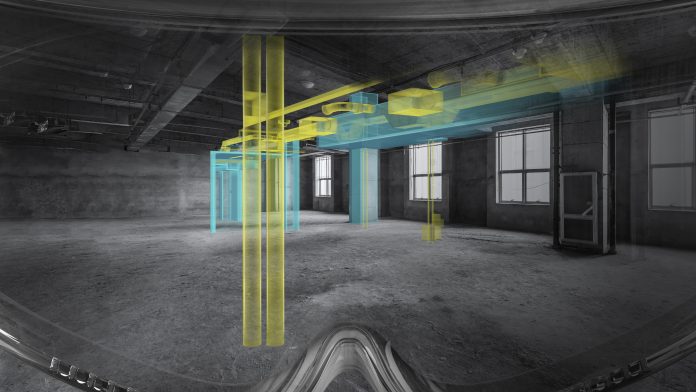David Mitchell, founder and CEO of XYZ Reality, talks about the deep-rooted limitations of innovation and how augmented reality in construction is delivering long-overdue change
Despite its size and contribution to the UK economy, the construction sector has been slow to benefit from the advanced technologies and digital transformation that have reinvented other industries. In the aftermath of the Covid lockdown, the then prime minister encouraged the nation to “build, build, build” to help restore our economy to working order.
And yet, reports suggest that the construction industry could take years to make up the ground lost already through lockdown, compounded by prevailing productivity issues and lack of modernisation. With economic and social upheaval continuing, there has never been a more critical time to address longstanding challenges and embrace technological change.
For decades, the industry has suffered from flat productivity. Mark Farmer’s 2016 report Modernise or Die highlighted the inherent conservatism of the industry; an overreliance on traditional methods unchanged for decades.
What’s been missing from the debate, however, are the reasons behind the slow uptake of advanced technologies. Since the advent of mobile computing, in particular, the industry has been restricted by the availability of technology with the power and capacity to serve our work environment and obstructed in its pursuit of the “build it right, first-time” goal.
Construction industry must adopt heavy-duty innovation
Laptops, tablets and mobile phones are designed to meet the data demands and computational tasks of the majority of professional users, supporting digital transformation across industries and equipping the masses for mobile working. However, while these tools may help construction engineers to see emails and spreadsheets away from the office, they are ill-equipped for delivering complex, large-scale design data where it is needed for use.
Until now, mobile technologies have been fundamentally limited in their suitability for construction sites. In fact, computing hardware has only served to reinforce one of the biggest bottlenecks in our industry – the need to convert complex 3D design models into thousands of 2D drawings for use in the building field. In this way, hardware limitations have constrained the extension of an end-to-end 3D process in construction and withheld opportunities to address core issues of productivity.
You could say it is not the industry that has held back on innovation – innovation has held back on the industry.
On-site errors, rework and clashes of 2D models
The widespread adoption of BIM in recent years has offered a significant step forward, addressing many prevailing issues in design and coordination. But it doesn’t solve the build problems of on-site errors, rework and clashes, which are most often the result of the 2D conversion.
I saw this first-hand during my time as a digital construction manager working on large-scale projects across Europe. Because the technology has not previously existed to take 3D BIM models onto the site, we have been bound to convert the 3D design into 2D drawings and back into 3D construction, with all of the resulting delays and errors that this process causes. In 2016, on a project with J Coffey Construction, I had an opportunity to explore a proof of concept for paperless construction which removed 2D from the process. The result was a massive 500% increase in productivity and validation that 2D was the problem.
2D is not a natural language for humans, we naturally see the world in 3D. Yet, industry professionals are required to interpret 2D drawings, conceptualise the 3D asset and then build on-site within construction tolerances. What’s more, validation of these works using laser scanners, 360 cameras and other similar reality capture solutions only show errors after they have occurred and reinforce a reactive mindset.
Savings of up to 20% can be made on construction project costs just by cutting out the inaccuracies, decision delays and rework on-site that is caused by the 2D bottleneck.
Ultimately, it supports immediate decision-making by equipping construction managers with the knowledge they need to build it right, the first time.
Design-build-validate with augmented reality in construction
This is where advanced technologies like augmented reality (AR) are bringing big change to our industry. AR is a form of immersive technology that overlays a real-life view with computer-generated 3D imagery. Unlike virtual reality, where the user steps into the virtual world created by the application, AR keeps your feet firmly on the ground and projects digitalised text and images through a smartphone, visor or heads-up display.
We’ve been the first to combine AR with the power of today’s mobile computing capabilities so users can view hyperscale BIM models on-site, in real-time and within construction tolerances. This is what we call “Engineering Grade AR” and is the foundation for HoloSite, which is the only product to custom-integrate Engineering Grade AR within a safety standard-compliant hard hat to take the full power of advanced technology to the field.
Engineering Grade AR also delivers a fundamental change in mindset, enabling teams to shift from a reactive approach of fixing errors that are out of tolerance to proactively preventing inaccuracies and issues occurring in the first place.
Tackling inaccuracies at the lowest value stage enables rapid, low-cost corrective action. Our technology is uniquely able to deliver 3D information on site to within 5mm accuracy, so there are no deviations from the design, no need for rework and no knock-on clashes or delays.
The future of augmented reality in construction
It’s fair to say that we, as an industry, are acutely aware of our poor reputation in delivering on time, on budget and to specification. Many of us will have experienced the challenges of translating complex 3D models into 2D plans, and the frustration of errors and inaccuracies revealed when it is costly and complex to fix them.
We have also seen technology bring change to industries around us, though limitations of mobile hardware prevented us from bringing similar benefits on to the construction site. Today, with many of these limitations overcome, I believe we will see an exponential increase in innovation.
But beyond the technology, the mindset shift from reactive to proactive is equally important. Being able to design, build and validate in 3D, coupled with the capability to access hyperscale BIM models on-site and in real-time, fundamentally changes the nature of construction and we expect to see it becoming a much more forward-thinking industry. This is a game changer that unlocks productivity, expands capability and stops errors before they occur. After all, why wouldn’t we build it right first time?

David Mitchell
Founder and CEO














